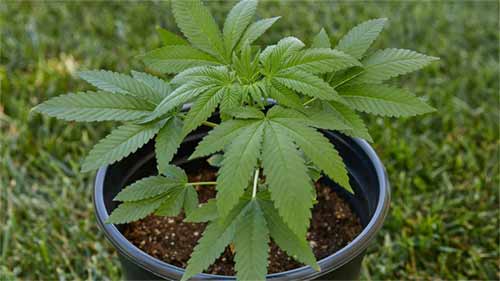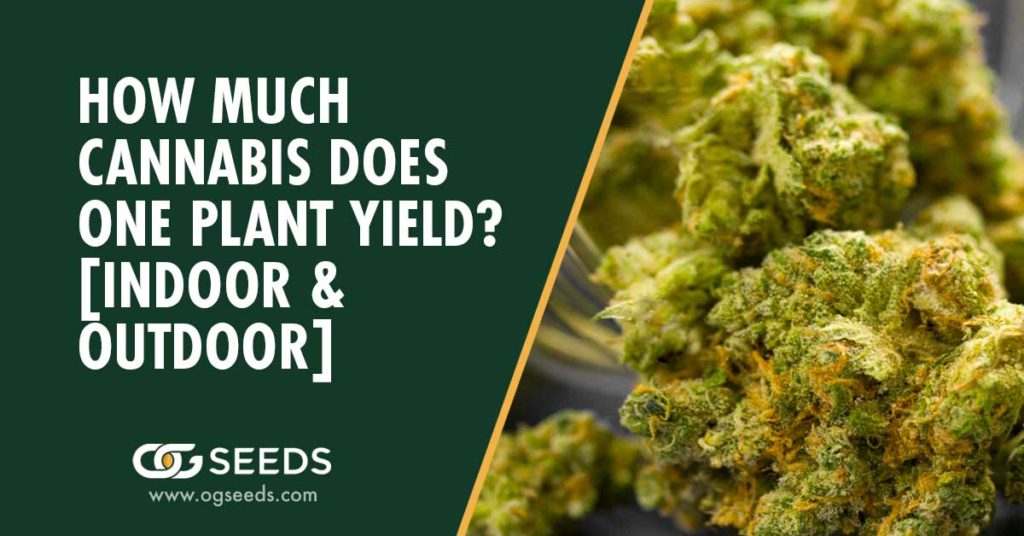
How Much Cannabis Does One Plant Yield? [Indoor & Outdoor]
How much cannabis does one plant yield? It all depends on your environment, the type of plant you’re growing, the quality of the cannabis seeds, and the techniques you’re using to get the most out of your crop. Planning and practice can make a big difference even if you are only growing one plant. Let’s not forget, however, that cannabis plants are sentient beings, meaning your plant is a living thing. Many factors affect your plant’s growth, and the same plant can produce a pound in one situation and a few grams in another. Read on to learn about all factors affecting yield and potency and how to maximize the output of your grow.
Table of Contents
What is Cannabis Plant Yield?
The yield per plant is the amount of bud your plant will produce after harvesting. Experienced growers will want to utilize the right methods and materials to ensure their crops grow thick and produce the highest bud yield.
Wet Yield Vs. Dry Yield
Wet yield and dry yield refer to the weight of cannabis plants before and after drying and curing, respectively. It refers to the weight of the plants as soon as they are harvested, which includes both the buds and any excess moisture. In contrast, dry yield refers to the weight of the dried and cured buds after all excess moisture has been removed. On average, the drying and curing process can result in a loss of around 50-70% of the wet weight, depending on the specific strain and the drying and curing methods used.
How Can I Maximize My Plant Yield?
Some growers use LED lamps, and others have HPS lamps. LED lights can lead to better yields while saving energy. If you are growing Cannabis outside, the sunlight can lead to more vigorous growth. Some have used LED lights to maximize their outdoor cultivation by placing these lights in a greenhouse, giving growers the benefits of the sun and artificial light for maximum potency and output.
![How Much Cannabis Does One Plant Yield? [Indoor & Outdoor]](https://ogseeds.com/wp-content/uploads/2023/02/How-Much_Cannabis_Does_One_Plant_Yield_900x650.jpg)
How Much Does One Cannabis Plant Yield On Average?
Many factors influence average Cannabis plant yield affect how big a plant gets, but generally speaking, if you are growing a healthy plant, you can expect these yields from one weed plant.
Indoor Average Cannabis Yield Per Plant
Indoor Cannabis plants will produce ¼ pound of buds or about 112 grams on average. Factors including the size of the pot you’re using to grow, the area of space in your growing room, and the type of strain will determine how much yield per plant your cannabis will produce.
Outdoor Average Cannabis Yield Per Plant
Outdoor Cannabis plants will produce ½ a pound of buds or about 224 grams on average. They will usually have a higher yield per plant due to the amount of area the plants have to grow.
What is The Most Weight One Cannabis Plant Can yield?
On average, about 4 ozs per indoor and 8 ozs per outdoor, but some strains have been known to yield as much as 20 ozs per plant. Strains that produce these heavy amounts are grown properly using the right techniques. Using more light and proper plant nutrition is a must, and techniques such as topping will help increase the yield significantly. It only takes a few plants to produce impressive yields if you cultivate them correctly. This can be done through giving them the right light and nutrients, and training your plants correctly.
Indoor Max Yields
With proper growing techniques and optimal conditions, indoor cultivators can expect to achieve yields ranging from a few ounces to several pounds per plant. Yields can be increased further through advanced growing techniques such as high-intensity lighting and hydroponic systems.
Outdoor Max Yields
The maximum yield of outdoor cannabis buds by weight can vary widely based on strain, climate, soil quality, and overall growing conditions. In ideal conditions, some outdoor cannabis plants can produce several pounds per plant yields. However, these high yields are unique, and more commonly, outdoor plants may produce several ounces to a few pounds of buds per plant.
What Yields More Per Plant Sativa, Indica, Or Hybrid?
In general, Sativa-dominant hybrids will be the most generous plants, though you may be surprised by some Indica-dominant strains that reject this expectation. It’s also possible to search for high-yielding cannabis seeds in general. Experienced growers will gain the most from any strain with the right techniques.
What Are Some Of The Highest Yielding Strains?
- Big Bud: Big Bud is a classic strain bred for its massive yields and heavy, dense buds.
- Critical Mass: Critical Mass is another strain known for its high yields, with plants capable of producing up to 600 grams per square meter.
- Super Silver Haze: Super Silver Haze is a Sativa-dominant hybrid known for its large yields and fast flowering time.
- Northern Lights: Northern Lights is a classic indica strain known for its fast flowering time and high yields of dense, resinous buds.
- Girl Scout Cookies: A hybrid strain known for their high THC content and heavy yields of dense, resinous buds.
- OG Kush: OG Kush is a classic hybrid strain known for its high yields of dense, sticky buds.
- Amnesia Haze: Amnesia Haze is a Sativa-dominant hybrid known for its fast flowering time and high yields of long, sticky buds.
How Can One Weed Plant Produce?
Many factors affect how big a plant gets, but generally speaking, if you are growing a healthy plant, you can expect these yields from your weed plants. You’ll want to figure out how many plants you can fit in your grow space and see what training methods your plants will respond well to.
Average Outdoor Plant Yield: ½ pound of buds, or about 224g.
Average Indoor Plant Yield: ¼ pound of buds, or about 112g.
![How Much Cannabis Does One Plant Yield? [Indoor & Outdoor]](https://ogseeds.com/wp-content/uploads/2023/02/How_Much_Cannabis_900x650.jpg)
What Affects The Yield Amount Per Plant?
For your convenience we’ve listed the 7 factors that influence the yield of your plants the most so that you can come up with a growing strategy that best suits the needs of your plants.
- Genetics: This is a key factor, as some strains naturally produce larger yields than others.
- Lighting: This is a crucial part of maximizing your yield, and light requirements vary between different strains of cannabis. The quality and intensity of light, as well as the duration of the light cycle, can all have a significant impact on yield.
- Temperature and Humidity: Maintaining optimal temperature and humidity levels is crucial for keeping plants healthy and maximizing yields. Extreme temperature fluctuations and high humidity levels can cause stress and reduce yields.
- Nutrient Delivery: Nutrient requirements vary between plants, so it’s important to research the needs of the strain you’re growing to give them the right balance of nutrients. If you under or over fertilize you can affect both the yield amount as well as the potency of your bud.
- Water at the Right Times : Consistent and proper watering practices are important for maintaining healthy plants and maximizing yields. Over-watering or under-watering can both reduce yields.
- Pruning and Training: Training techniques, such as pruning and trellising, can help create an even canopy and promote better light distribution, leading to higher yields. You can also try the Screen of Green (SCROG) method to grow fewer cannabis plants with higher output. The Sea of Green (SOG) method entails growing many smaller plants and getting higher yields that way. Different strategies work better for different strains.
- Pests and Diseases: Infestations of pests or disease outbreaks can reduce yields by causing stress, stunting growth, or killing plants. Regular monitoring and prompt treatment are important for preventing cannabis plant yield loss.
Genetics/Strain Type
The type of strain is important for determining yield. Sativa dominant hybrid strains are known to yield more because of how tall and lengthy they grow. However, using the right techniques, such as topping, maintaining healthy nutrients, and using the right lighting, can increase the yield of any cannabis strain.
Environment
The environment you can provide your plants and how well suited it is to the strains needs is the biggest factor at play. Indoor plants typically produce less yield than outdoor plants for a few reasons, but partially due to the amount of space in the indoor growing area and the amount of light the plant absorbs.
Be careful growing outdoors unless you live in a sunny, Mediterranean climate that doesn’t have too many cloudy or rainy days. Remember that growing outdoors does come with its own set of limitations. You’ll only be able to harvest once or twice a year as opposed to growing indoors where you can harvest year round.
Grow Space Limitations
When growing cannabis, outdoor plants will typically produce a higher yield due to the space the plant has to spread out and grow. Indoor plants are limited to the size of the room they are growing in. If you spread the indoor plants apart enough to grow into bushier plants, you will plant less in the limited space.
The size of the pot that you use will also affect the nutrients dispersed to the bud. Outdoor growing will produce bigger plants based on the area underground that the roots have to grow and absorb nutrients.
Plant Management/Maintenance
For higher cannabis yields, proper plant management and maintenance are crucial. This management includes providing the plants with optimal growing conditions such as proper lighting, temperature, humidity, and nutrient levels and regular monitoring and adjustment as needed. Implementing proper pruning and training techniques, using high-quality seeds or clones, and providing the plants with adequate water and nutrients can also contribute to higher yields. Regular maintenance and monitoring of the growing environment are key to ensuring optimal plant health and growth.
Soil/Nutrients
Using high-quality soil and properly balanced nutrients are essential for maximizing cannabis yields. Healthy soil provides the roots with nutrients, water, and air to support robust plant growth. In contrast, balanced nutrients help plants reach their full potential by providing the right combination of macro and micronutrients.
Look for a well-draining mix that’s rich in organic matter like compost or worm castings. And don’t be afraid to supplement the soil with additional nutrients like compost tea or commercial nutrient solutions to ensure your plants are getting all the nourishment they need throughout their life cycle.
Remember to keep a close eye on the nutrient levels in the soil and adjust them as necessary to make sure your plants are getting the right balance of nutrients for to make sure your plants grow the best and yield the most.
Watering
To achieve the highest yield when growing cannabis, it is important to properly water the plants. Properly watering involves providing consistent, moderate water, so the soil is evenly moist but not soggy. The watering frequency will depend on factors such as the plant’s size, the growing environment’s humidity and temperature, and the type of soil used. It may be necessary to water less frequently during the flowering stage to avoid overhydrating the buds. Additionally, it’s important to monitor the pH of the water and adjust it as needed to ensure optimal nutrient uptake by the plants.
What Grow System Yields The Best?
The best grow systems for the highest yield of cannabis depend on the grower’s preferences, the scale of the operation, and the available resources. Here are three popular grow systems:
- Hydroponic systems use nutrient-rich water instead of soil to grow cannabis plants. Hydroponic systems provide precise control over growing conditions, which can result in faster growth and higher yields compared to soil-based systems.
- Aeroponic systems – By using a misting system to for nutrient delivery straight to the roots of the plants, faster growth and higher yields can occur compared to hydroponic and soil-based grows. The main issue is that they require more technical knowledge and resources to set up and maintain.
- Soil-based systems – This is the simplest and most affordable way to cultivate Cannabis. You can still produce large yields when growing with soil and less technical knowledge is needed to maintain your garden and deliver nutrients to your plants.
Ultimately, the best growth system will depend on the individual grower’s needs and goals which is why it is important to carefully consider all the factors at play for your individual set up to really maximize your yield.
What Type Of Grow Light Yields The Most?
The type of grow light that you make use of in your grow can influence the yield more than you may realize. There is no one size fits all light when it comes to growing Cannabis, but LED grow lights do show the most promise as far as energy efficiency, limited heat emission, and producing large yields. High-Intensity Discharge (HID) lights: HID lights, such as metal halide (MH) and high-pressure sodium (HPS) lights are what have been around for years and when set up correctly can also produce large yields but they use more power to do so. Ceramic Metal Halide (CMH) lights: CMH lights are a newer type of HID light which off the efficiency of HPS lights with the spectrum of MH lights.
The best grow light for you will depend on your specific needs and goals, so we recommend doing plenty of research and looking at all factors at hand, such as cost, energy consumption, heat emission, and light spectrum, before deciding.
How To Achieve The Best Cannabis Yields
To achieve the highest cannabis yields, growers should focus on providing their plants with ideal growing conditions, such as proper lighting, temperature, humidity, and nutrient levels. Regular monitoring and adjusting of these factors are key to ensuring optimal plant health and growth. Additionally, using high-quality seeds or clones and implementing proper pruning and training techniques can increase yields. It’s also important to choose the right growing medium (soil, hydroponic, aeroponic) and to have the proper equipment and tools for your setup. Proper research and experimentation can help growers make informed decisions and achieve maximum yields.
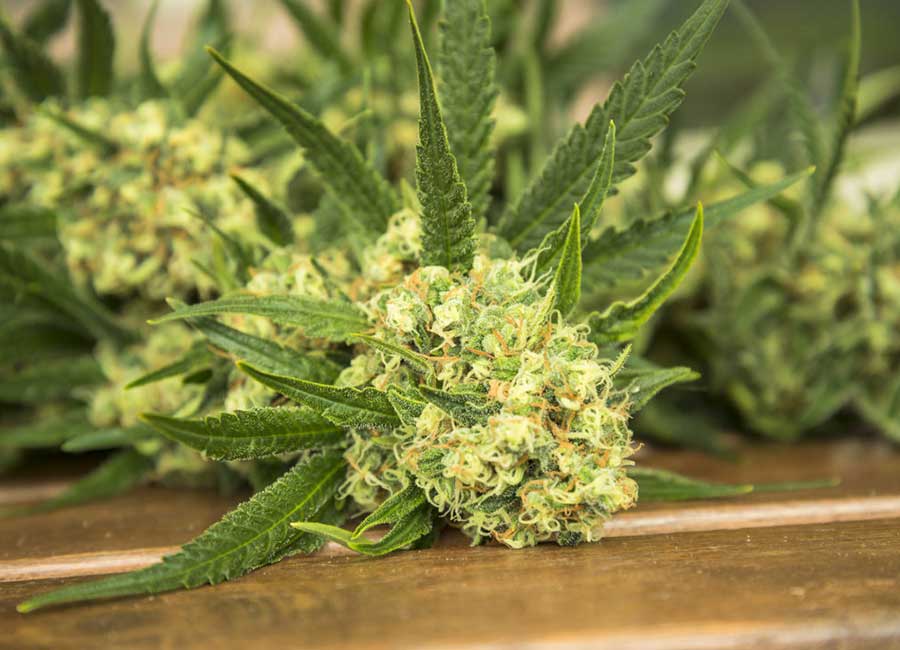
Vegetate Longer
Giving your plants a longer vegetative stage before flowering can make a big difference. During this stage, your plants will be developing new branches, leaves, and a strong root system. The longer you let them veg, the bigger and stronger they’ll get, leading to larger yields when it’s time to harvest those sweet buds.
It’s important to keep in mind that the ideal length of the vegetative stage can vary depending on the strain and growing conditions. Some strains might benefit from a longer veg period, while others might do just fine with a shorter one. Generally speaking, most strains will need around 4-6 weeks of veg time, but some growers like to go longer to really maximize their yields.
Provide Proper Environment
Giving your plants the right amount of light, temperature, humidity, airflow, and nutrients is how you maximize your yields. To get started, make sure you’re providing your plants with at least 18 hours of bright light per day during the vegetative stage, anddo research on the lights that work best for your situation. Cannabis plants prefer temperatures around 70-85°F and the humidity between 40-60% during the day and 50-70% at night.
Make sure your garden is well-ventilated, as this can help prevent mold and mildew growth and also gives your plants enough CO2 to grow how they need to. We recommend using a balanced fertilizer every 2-3 weeks during the vegetative stage and then switching to a high-phosphorus one during flowering. If you over-fertilize, you can hurt your yield, so follow the instructions.
Keep your plants well-watered, but let the top inch of the soil dry out before watering again. And don’t forget to prune yellow or dying leaves and use techniques like topping, FIMing, or LST to encourage bushier growth and more bud sites. If your growing strategy takes all of these factors into consideration and you can supply all the best conditions as a result, you will have a lush garden and a fruitful harvest in no time!
Use Nutrients Correctly
Using the correct nutrients and delivering them properly nutrients correctly, it is important to provide the right balance of essential elements that plants need for growth, such as nitrogen (N), phosphorus (P), and potassium (K). Also, micronutrients such as magnesium, iron, and calcium are important for healthy growth. There are 4 main things to keep in mind when it comes to planting nutrients.
- Follow the manufacturer’s instructions: Always follow the instructions on the nutrient label to avoid over-fertilizing or under-fertilizing, which can reduce yields.
- Use a balanced fertilizer: During the vegetative stage, use a balanced fertilizer that provides a good ratio of N, P, and K, with the right amounts of micronutrients. Switch to a high-phosphorus fertilizer during the flowering stage to support flower development.
- Monitor pH levels: Regularly monitor the pH level of your nutrient solution to ensure it is in the optimal range for plant uptake of nutrients. A pH level between 5.5 and 6.5 is ideal for most cannabis strains.
- Watch for signs of nutrient deficiencies: Yellow leaves, stunted growth, and other signs of stress can indicate a nutrient deficiency. Adjust your nutrient regimen accordingly to correct the deficiency.
Maintain Your Plants
To maintain cannabis plants for higher yield, follow these tips:
- Provide adequate light: Cannabis plants need a lot of light, at least 18 hours per day during the vegetative stage and 12 hours per day during the flowering stage.
- Control temperature and humidity: Maintain a temperature of 70-85°F and relative humidity of 40-60% during the day and 50-70% at night.
- Water regularly: Ensure the soil is evenly moist but not soggy. Allow the top inch of soil to dry out before watering again.
- Fertilize appropriately: Use a balanced fertilizer every 2-3 weeks during the vegetative stage and switch to a high-phosphorus fertilizer during the flowering stage.
- Prune and train: Remove yellow or dying leaves and use techniques like topping, FIMing, or LST to encourage bushier growth and more bud sites.
- Monitor pests and diseases: Keep an eye out for common cannabis pests like spider mites and aphids, and treat them promptly if detected.
- Flush before harvesting: Stop fertilizing 2-3 weeks before harvesting to allow the plant to flush out any residual nutrients and produce better-tasting buds.
Utilize Training Methods
Utilizing training methods is a crucial aspect of maximizing cannabis yields. By controlling the growth habit of the plants, you can increase the number of bud sites, leading to higher yields. Several popular training methods include topping, FIMing, LST, and SCROG. Here’s a brief overview of each:
- Topping: This method involves removing the top growth tip of the plant to encourage the development of multiple branches.
- FIMing: This method involves removing part of the growth tip of the plant to encourage the development of multiple branches.
- LST: Low-stress training involves gently bending and tying down branches to encourage horizontal growth, which can increase the number of bud sites.
- SCROG: Screen of Green is a method that involves using a screen to train the branches to grow horizontally and create a flat canopy.
Train your plants gently and consistently to prevent stress and damage regardless of your chosen method.
Incorporate CO2 In Your Grow
Carbon dioxide helps photosynthesis, which uses sunlight to convert CO2 and water into sugar. The plant will only grow with a certain amount of sugar it stores until depletion. Increasing carbon dioxide ensures that there will be plenty of stored sugar, and it will not deplete quickly.
Most growing will use CO2 bottles in the growing rooms to incorporate CO2 into their plants. It is best to use CO2 during the vegetative state while using slow-releasing CO2 bottles indoors.
Adding the right amount of CO2 to your grow room at the right time will ensure you will increase your bud’s yield.
Final Thoughts – How Much Weed Does One Plant Yield?
So there you have it, fellow growers and smokers! We’ve explored the wild world of weed yields, and now you know just how much cannabis one plant can produce. While there’s no exact answer to this question (because let’s face it, growing weed is more of an art than a science), you can expect to get anywhere from a few grams to a few pounds per plant, depending on a variety of factors.
Genetics and the growing environment can mainly influence the average yield of a Cannabis plant. Additionally, the cultivation or training methods used. Ready to start your cannabis cultivation journey? Check out our seed bank and our blogs! We’re happy to provide all the information you need to have an amazing grow. We’re even happier to provide you with the best seeds on the internet.
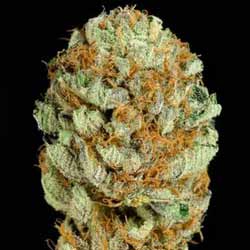
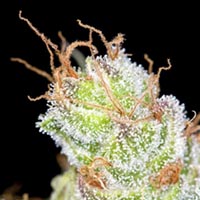
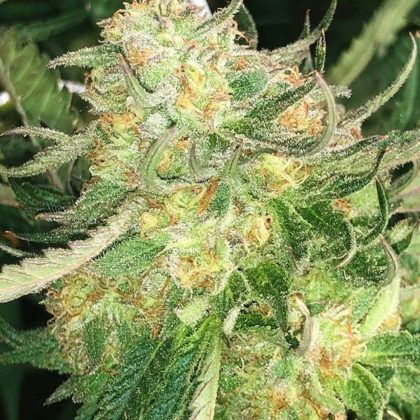
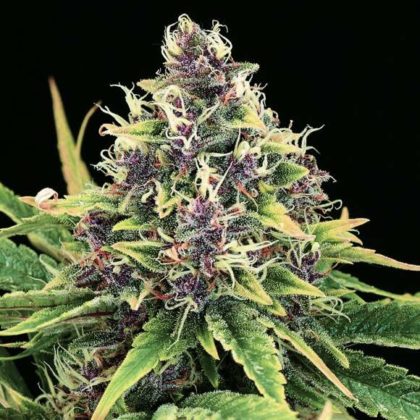



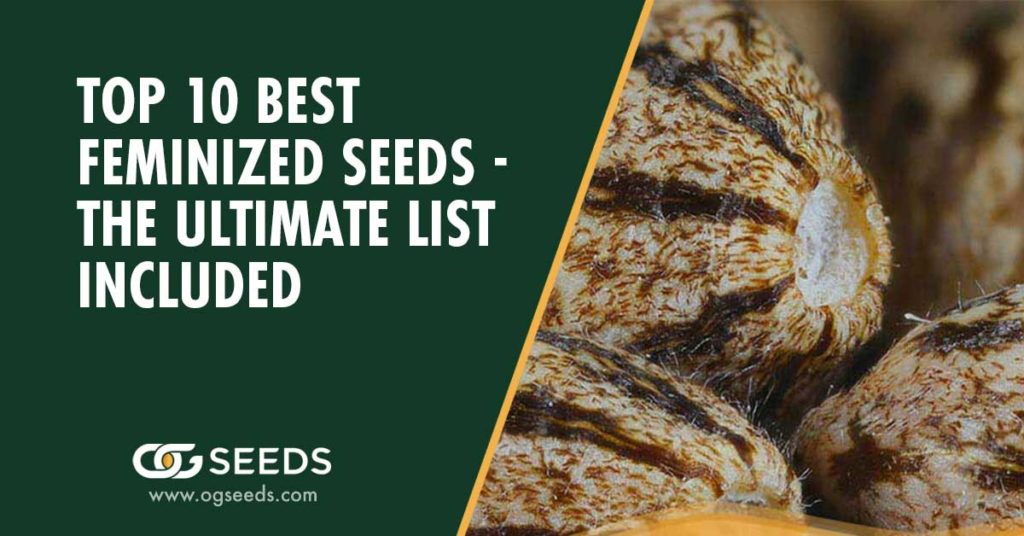
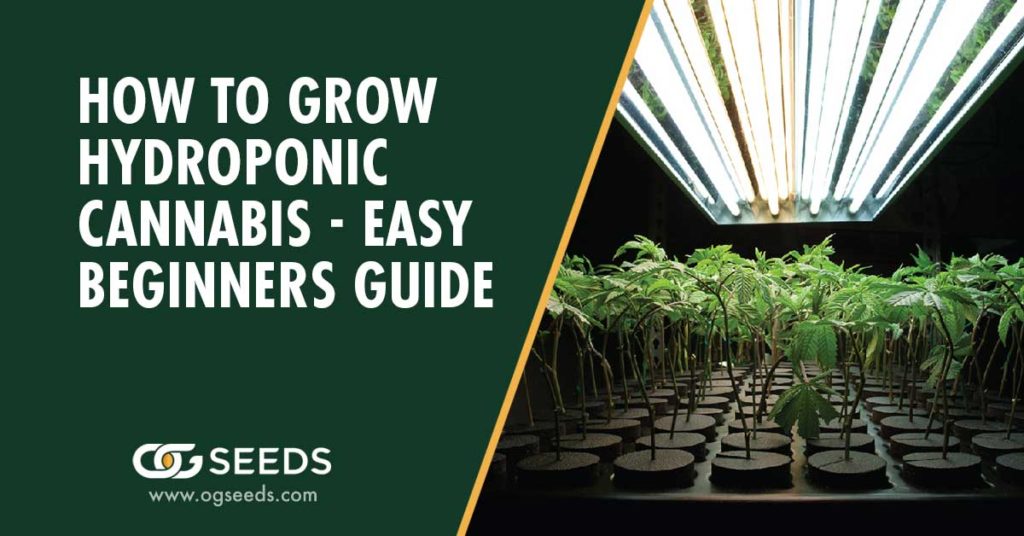
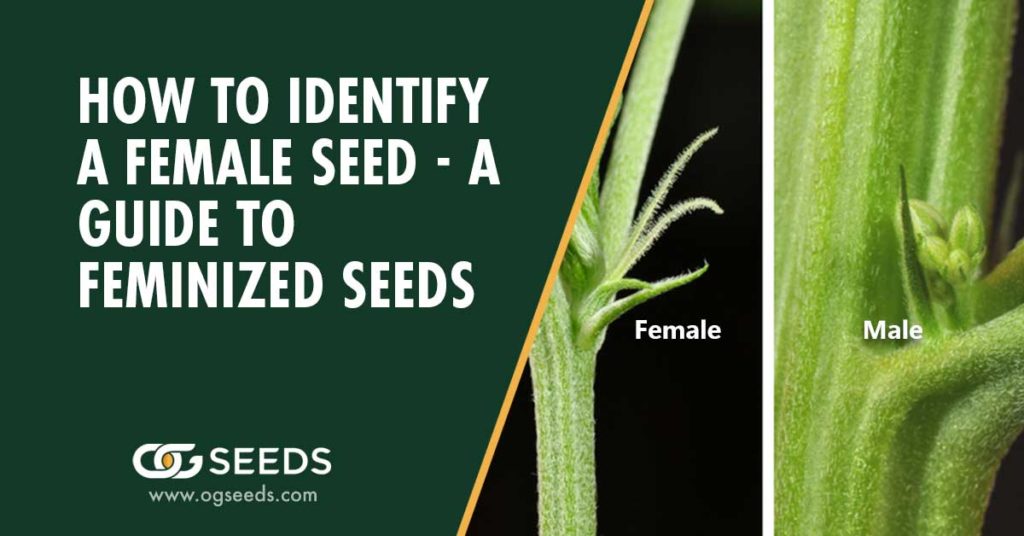
![How Long Does It Take To Grow Cannabis? [Indoors Vs Outdoors]](https://ogseeds.com/wp-content/uploads/2023/01/How_Long_Does_It_Take_To_Grow_Weed_Indoors_Vs_Outdoors_1200x628-1024x536.jpg)
